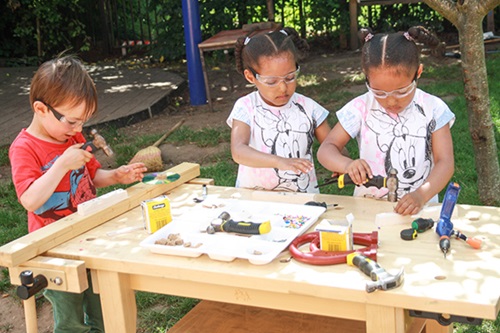Introducing woodwork in the early years
A valuable investment in children’s development
| October 2020Why woodwork?
It is more important than ever for the new generation to be able to think creatively and develop problem-solving skills. Woodwork exercises such skills as children make their own choices and learn through trial and error. It sparks creative thinking and imagination, qualities that are at least as important in our changing world as the practical skills gained. Woodwork encompasses all aspects of learning and development, supporting maths, scientific investigation, physical coordination, language, and vocabulary, so it can be central to your curriculum. Initially, children are taught how to use the tools safely and given opportunity to try techniques in appropriate ways. As they gain mastery, delight and pride give their self-esteem a visible boost. Learning progresses at each child’s individual pace. Once they have mastered the basic skills, they move into open-ended exploration, making unique creations. Now their creative thinking and confidence in problem-solving flourish as they meet and resolve their own challenges.
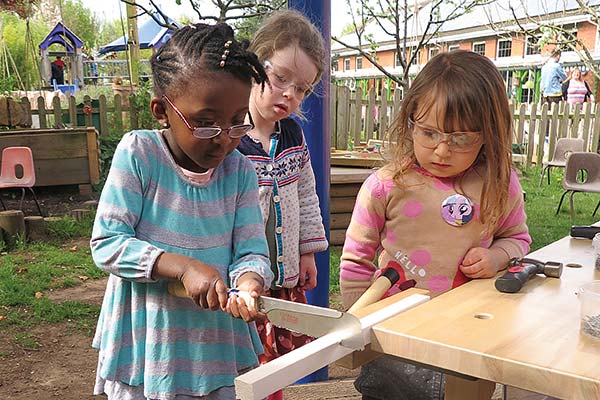
Anyone who has witnessed young children tinkering away with tools will know how deeply engaged they become for sustained periods of time. In fact, it is not unusual for children to spend all morning at the woodwork bench. Woodwork employs hands, hearts and minds. The smell and texture of wood, the sounds of hammering and sawing; the use of strength and coordination, the feel of real tools, the opportunity to work with natural materials, the deeply engrossed mind: all go together to captivate young children.
“Woodwork is active learning at its best!”
Currently there is a surge of interest in woodwork provision worldwide. In an ever-growing number of settings we can hear the tap-tapping of hammers and the sawing of wood. The renewed interest in woodwork is in part a reaction to our increasingly digital world, in which children now learn to swipe before they can walk. They are surrounded by complex technology but this has limited their experience of basic technology, with fewer opportunities to watch and learn and to understand processes. Woodwork invites children to explore their physical world with real tools and authentic materials, and provides a solid foundation for creativity.
Fortunately, working with tools leaves a deep memory – so even if early childhood education is their only experience of woodwork, it will leave a long-lasting impression.
“As children make with wood they are learning skills that will empower them to shape their world.”
Learning and development
When we analyse children’s woodwork it is extraordinary to see how it encompasses all areas of learning and development and invites connections between the different areas. It embraces all the characteristics of effective learning and fosters confident, creative children with passion for life-long learning.
Personal, social and emotional development
Children are empowered by being respected and trusted. They gain confidence and a sense of responsibility when allowed to work with real tools. As they master more tools and techniques, they take pride in accomplishing increasingly complex tasks. This imparts a can-do attitude and provides children with a strong sense of agency and a proactive disposition, as well as the belief that they have the power to help shape the world around them.
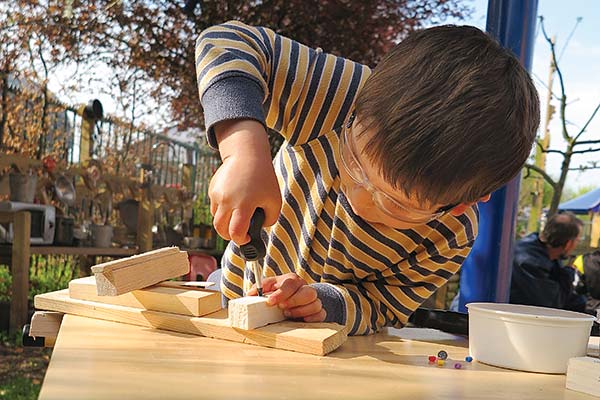
Children develop sustained attentiveness as they persist. There are two layers to their concentration: first, children have to focus due to the nature of the tools; second, they engage in deep-level problem solving because they are so motivated to construct their desired project.
When children discuss and plan a project together, their social skills develop. They learn the value of sharing ideas and learning from others.
“The emotional impact of woodworking is that it gives children that sense of achievement: ‘Yes! I can do this!’ Experience builds skills and knowledge which strengthen understanding: a positive cycle. Parents see happy children, further strengthening the whole ethos of positivity and empowerment.”
Physical development
Hand-eye coordination is basic to woodwork and children gain increasing control over their bodies as they develop agility and dexterity, manipulative skills, and muscular strength. Woodwork incorporates fine motor skills (holding a nail, screwing) and gross motor skills (hammering, sawing). Children’s core strength is developed as they push/pull (sawing, filing), rotate (using a screwdriver, drill, wrench, vice), lever (using a claw hammer or Japanese nail puller) and rub (with sandpaper). Experience of using tools becomes part of children’s physical “vocabulary”. Children also learn self-care, for instance the importance of protecting their eyes with safety glasses.
Communication and language
Natural conversation occurs among adults and children in the woodwork area. Because wood can be used in countless ways, possibilities are thoroughly discussed. Children’s language of thinking evolves through experience. In the project development stage, children express ideas; dialogue ensues as they reflect and modify their plans. Adults introduce new vocabulary to enable children to discuss their work with greater clarity. Learning to use new tools builds attention skills; children learn to listen carefully in order to understand instructions.
Mathematics
Numeracy is basic to woodwork. Children measure pieces of wood; they experience shape and weight. Constructing three-dimensional forms develops their spatial awareness. Adults have ample opportunity to extend children’s mathematical understanding: having them estimate which is the best length nail to use, for example, or how long a piece of wood needs to be for a particular purpose. Many mathematical concepts are related: matching with classification; counting with measuring; comparison with weight and size. Children are fascinated to calculate a tree’s age by counting its rings in cross-section. Be sure to include a wide range of mathematical equipment in your woodworking area (rulers, tape-measures, set-squares, spirit levels).
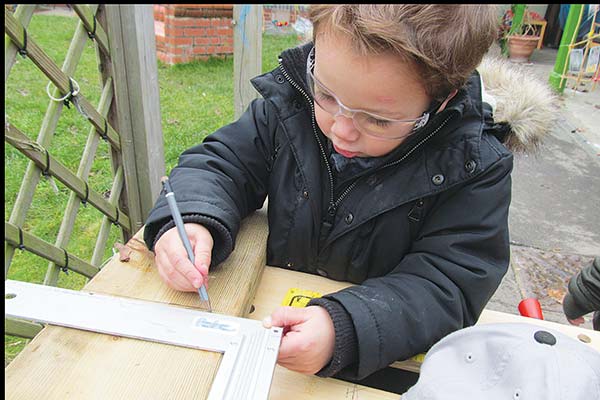
Understanding the world
Becoming familiar with trees and wood is part of making sense of the world. Trees are essential to life on our planet, and children are intrigued to learn about various kinds and about where and how they grow. Even young children begin to appreciate the interconnectedness of life and our dependence on oxygen released into the atmosphere by trees and other plants. If possible, take children into the woods to investigate a tree’s trunk, branches, leaves and roots. Planting a tree is a positive experience. Learning can branch out, for example by viewing leaves on a light box, examining different vein structures, making prints with leaves and learning about animals that live in trees. Talk about wood: what it is, where it comes from and its uses. Investigate wood as a material. What are its properties? It floats, it burns, it creates sawdust when cut, it gets hot when rubbed. Explorations can diversify – for instance, after wood is burned, it might be used to make charcoal drawings.
Expressive arts and design
Woodwork’s greatest asset is its contribution to children’s creativity. When creating they become designers, architects and artists. I avoid set tasks such as having every child build a bird box, but rather encourage them to make whatever their interest suggests. This keeps enthusiasm and engagement high, and produces amazingly varied results, from hedgehogs or flying lampposts to superpower heli-planes.
Thinking creatively is a life skill that impacts on all areas of learning. It will help children develop innovative ideas and influence how they respond to opportunity and adversity, enabling them to see options and evaluate possibilities in the future.
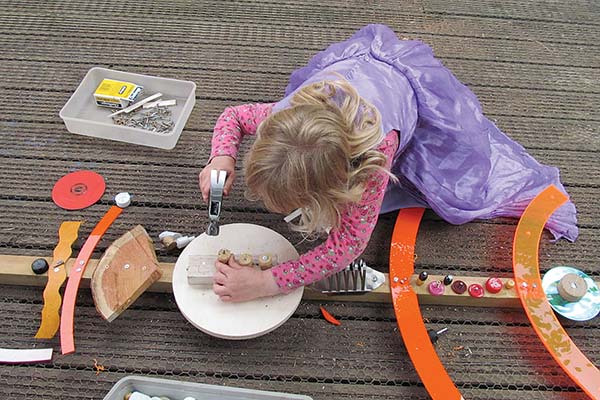
“Woodwork is a powerful tool for developing children’s creative and critical thinking. There are countless opportunities for children to solve complex problems and express their limitless imagination.”
Literacy
Literacy is about expressing thought through writing. In woodwork, children express their ideas through creating, laying the mental foundation toward expressing themselves through the more abstract medium of the written word. There is also plenty of scope for mark-making, on the wood itself, on paper while developing design ideas, or writing about their work afterwards. Many good children’s books and stories relate to wood, carpentry, and forests, and can be linked to the woodworking area.
Conclusion
It would be wonderful if every child could experience woodwork. As a practitioner, it is a joy to see children so deeply focused on an activity and to witness their growing confidence, their persistence despite challenges and their resilience in the face of failures. It is a delight to watch their creativity, observe their problem solving and see their pride in their achievements; it always leaves me feeling uplifted.
As children construct with wood they are learning skills that will empower them to shape their world. Let’s provide all children with this valuable opportunity.
Further information
Click on this link to find out about Pete’s new online training courses: https://irresistible-learning.co.uk/woodwork-cpd-online-course/
If your setting is already doing woodwork, participate in the Big Bang Research Project which is researching the impact of woodwork on children’s learning and development: https://irresistible-learning.co.uk/woodwork/the-big-bang-research-project/
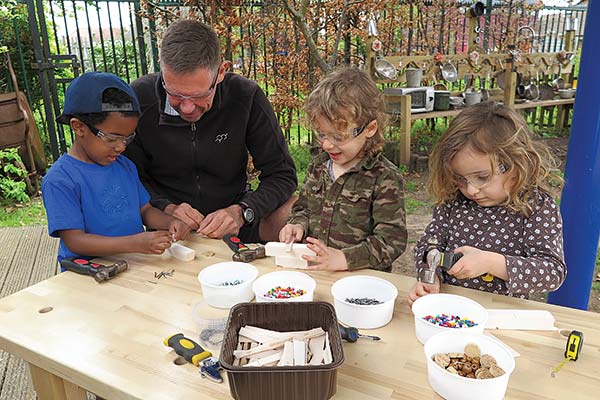
This article is compiled from our free resource booklet Woodwork in the early years.





